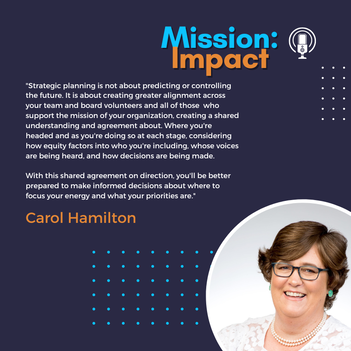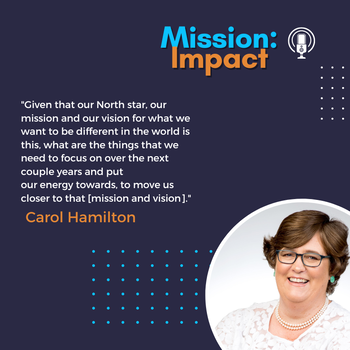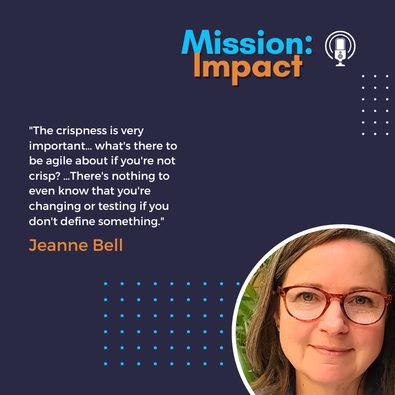Mission: Impact podcast & blog
Build a better world without becoming a martyr to your nonprofit cause
Listen on:
What is nonprofit strategic planning? Nonprofit strategic planning is a step-by-step process that helps you set priorities for your organization for the medium term – generally 3-5 years. You gather insight from your stakeholders, identify the common themes, explore possible futures and make decisions about where you want to focus your organization’s future in service of your mission. As part of the process you will clarify your why, what and how. What your nonprofit can expect from strategic planningStrategic planning is not about predicting or controlling the future. It is about creating greater alignment across your team, board, volunteers and all those who support the mission of your organization – creating a shared understanding and agreement about where you are headed. And at each stage, consider how equity factors into who you are including, whose voices are being heard and how decisions are being made. With this shared agreement on direction, you will be better prepared to make informed decisions about where to focus your energy and what your priorities are. A strategic plan is a process, not just a documentIt is also not just about the document – the strategic plan itself. That is a product of the process certainly. Yet it is really about the conversations that stakeholders have over the course of the process. Those conversations are what build the alignment and that shared understanding and ultimately the buy in that can be so elusive. It would be much easier and faster to decide one afternoon to “write” your organization’s strategic plan. Efficient for sure. Perhaps even satisfying for you as you are writing it. But ultimately that plan will fall short because it only represents your vision for the nonprofit organization. Nonprofit organizations are a collective effort. Typically tackling some of society’s biggest challenges. Getting closer to your organization’s mission effectively takes everyone pulling in the same direction and not working at cross purposes. Does my organization need a strategic planning retreat?It is also not just a retreat. Oftentimes, people will reach out and ask whether I can come facilitate their strategic planning retreat. But without the preliminary and fundamental step of discovery – or the listening tour – you do not have the grounding you need for a truly comprehensive and deep strategic planning process. Our 5-Step Nonprofit Strategic Planning Process for intentional, insightful, inclusive goal setting1. Your Strategic Plan kick-off onboardingHow you start the strategic planning project really makes all the difference. Getting clear about your goals for the project itself, who needs to be involved, the time frame you are planning for, as well as the strategic questions you are grappling with as an organization will set you up for success. Orienting the system to the processConsider holding a few kickoff events with your stakeholders to ensure that everyone is clear about how you are approaching the strategic planning process. Often this include sessions for staff, board, and other volunteers. These events typically include an overview of the project and process, who will be involved including any consultants you have hired to support and guide the process, as well as a conversation about what people are hoping for in the process and what their concerns are. After the event, it is very helpful to send a written document to everyone that reiterates the same information so that everyone has something to refer back to as the project progresses. Assembling your teamOne of the first tasks is to pull together a group of staff and board that will form your strategic planning committee or task force. The job of this group is to steward the process and advise on key decision points along the way. It is NOT their job to make all the decisions about the final three-five goals that will make up the main elements of your actual strategic plan. Who should be on the strategic planning task force? Board, leadership, staff?The task force should include people empowered with the organization to make decisions. This typically means the executive director, the board chair and ideally the incoming board chair as well as staff and other volunteers who will be influential about your organization’s future. A smaller group will find it easier to make decisions (up to five people). With a larger group (up to nine people) you will be able to better represent different elements of the organization and your stakeholders, yet you may need to have a smaller group designated to have the final say on decisions. What is the role of the strategic planning task force?Some of the task force’s tasks at the beginning of the process include identifying the stakeholders who are vital to your organization's future, how input from them will be gathered and what questions you will be asking them. Who is important to shaping your organization’s future? Often stakeholders include staff, board, volunteers, community partners and allied organizations, as well as those your organization serves and funders. Have you fully considered power dynamics as you prioritize stakeholders? How do you plan to gather input from those stakeholders who are part of historically marginalized communities? What supports may they need to fully participate in the process How a nonprofit strategic planning consultant can helpWhen you are working with a consultant, they will help you sketch this out as well as support you in making decisions about how the information will be gathered. You will need to decide whether it is with one-on-one interviews, focus groups and/or surveys. Deciding what mix of approaches makes sense in your organization’s situation is one of the key tasks for the group during the kickoff phase. Once those decisions have been made, the discovery phase or listening tour can start. 2. Discover: Listen to your key stakeholders before you start making decisions!This step in the process you are going on a listening tour to discover what is the organization’s current state, what are its strengths, challenges, what is its history and what are the collective hopes and aspirations for the organization’s future. One of the benefits of working with a consultant is that they can take on the time-intensive work of talking one-on-one with people, facilitating focus groups and developing, launching and analyzing surveys. In addition, consultants will often have a bank of questions that they will use as a spring board to customize for your situation. If you choose to conduct the input process yourself, be sure to orient your volunteers to how to conduct interviews and be clear about the process for capturing notes so that the results can be analyzed into themes. How are you making participation in your accessible for community members?Another consideration when you are conducting your listening tour is to think through the systemic barriers that may prevent those you serve and support from participating in your listening opportunities. How will you make it possible and accessible for people you serve to participate? Will you offer stipends, feed people, provide or reimburse transportation and child care? If your input sessions are being held virtually, do people have the digital access needed to participate? 3. Explore your stakeholder insights, wider trends and your potential futuresOnce you have a solid picture of where you are as an organization, your strengths and challenges, what some of the aspirations are that people have for the organization, you will need to share these findings with your planning group so that they can make meaning of them. The planning group should include your board and staff. This is the group that you will gather at a strategic planning retreat or over a series of strategic planning sessions. What can you expect during a strategic planning retreat or strategy planning sessions?A strategic planning retreat will typically start with an overview of the findings from the listening tour and then time for small group and large group discussion of what meaning the group makes of the findings. Other agenda items will likely be an exploration of wider trends, envisioning the organization's future, identifying major goals, action steps and success indicators, identifying key criteria for future decision making as well as a review of your organization's mission, vision, values to update them as necessary. The retreat itself will be a mixture of small and large group conversations and activities. Multiple ways of knowing and communicating should be included, such as drawing, skits and other ways to tap into everyone's imagination. There should also be time for individual reflection and group dialogue to be inclusive of varying thinking and communicating styles. A series of online strategy sessions will typically range from 90 minutes to three hours at a time and use a combination of a video conference platform such as Zoom with work being done digitally through a google doc or Mural board or other online white board tool. Why its important to explore the wider environment and trendsWith the foundation of what the current state of the organization is, the group should also look wider and identify the wider trends impacting your organization. Your organization does not exist in a vacuum. It exists in a wider ecosystem of the community you are in, the field you are in, as well as the wider society and world. What trends does the group see politically, economically, socially, environmentally, and technologically? Of those trends, which ones will most likely have an impact on your organization furthering its mission. Imaging the future of your nonprofit organization With this wider perspective in mind, lead the group in a variety of exercises to help them imagine a new future for the organization. Think about how you can integrate different ways of knowing into your exploration process. Get beyond just words and integrate opportunities to bring in different senses and modalities such as drawing, skits, and songs. This is the part of the exploration process when you can let the imagination fly freeing and think audaciously. All these possibly wild ideas and aspirations will likely not make it into the final plan yet they help uncover new options that the group might not otherwise consider. 4. Decide your nonprofit priorities, based on mission, vision & valuesYou now have fun and inspiring pictures of potential futures for the organization. Unfortunately too often this is where people often stop. And then they wonder why they feel overwhelmed by a ‘plan’ that looks more like a wish list. Setting priorities for your nonprofit organizationYou then need to lead the group through a series of exercises to set priorities and make decisions about which of these options you will put your energy behind. You cannot do everything. This is another element of the process that is especially helpful to have the support of strategic planning consultants. They have no agenda about what ultimately gets decided and prioritized – instead they have expertise in helping groups have effective conversations about options and actually make decisions. As you are making those decisions, consider whose voice is being prioritized and how each decision might impact different groups you serve. Update your mission and visionYou may have noticed that I did not start the process with a mission and vision exercise. This is where many other strategic planning consultants start. I recommend instead that groups refine their mission and vision statements at the end of the process. You then benefit from all the conversations that the group has had over the course of the process, and it is more a matter of confirmation. Does your current mission statement accurately reflect where the organization is going? Does your vision statement accurately describe the change you are trying to make in the world? What needs to be updated or refined? 5. Plan & Act: Turn your strategies into action steps not a wishlistSuccess indicatorsOnce you have decided on three and up to no more than five big goals, lead the group through conversations to identify what action steps will move those goals forward. Provide ways for feedback to be gathered. You may need to go through several iterations. For each action step, also define what success will look like. How will you know you have made progress? The strategic planning task force will take the rough draft created by the larger planning group, clean up the language and do the final refinement so that it is clear. Check one last time for shared agreement with the larger group. Operationalizing your nonprofit strategic planUsually your board will vote on the final version of the plan and approve it. Having been closely involved in each step of the process, and provided multiple opportunities for input and feedback, this approval ideally is a straightforward process. Staff then need to operationalize the plan and decide who is going to do what, by when, in Year one. The process of creating an annual implementation plan will include what are you focusing on in year one – what needs to happen first? And what are more specific tasks that need to happen to move your action steps forward? Keeping the plan freshYou now have a strategic plan and a year one implementation plan that captures the shared agreement among your stakeholders about where you are going to put your energy to move your mission forward more effectively. Yet the world does not stand still – new opportunities and challenges will emerge. Before you are finished with your process, work with your strategic planning task force to agree on how you keep track of the plan. How will you integrate it into regular planning practices? Board meetings, staff meetings? Keep track of progress? Evaluate when you need to make adjustments and updates? Get clear and come to agreement about what your practice is for keeping the plan relevant and front of mind. You will be continuously learning and adapting. Goals that truly help an organization forward are dynamic and require ongoing effort, reflection, and adaptation to changing circumstances and new understandings. Reconnecting with your external stakeholder groups You also need to think about how you will share the summary of the input gathered to your wider stakeholders who may not be part of the planning sessions themselves. You asked for their input – help them understand how you are going to use their information. Your goal in gathering input from them is not only to gain their perspective but also to engage them in the future of your organization. Do not undermine the trust you have built by asking them for input and then not closing the loop and sharing some version of the findings summary. Building buy in through engagementStrategic planning is an opportunity to do a deep engagement with your stakeholders to get them excited about and shape the future of your organization. Using the five-step process – kick off, discover, explore, plan and act, plus deciding on a process for keeping the plan fresh will create the level of buy in you need to have your plan be relevant and usable for guiding your organization’s future.
 In episode 90 of Mission: Impact, Carol Hamilton goes solo and talks about:
Strategic planning:
Kick Off
Keeping the Plan Fresh
Important Links and Resources: Common Mistakes Organizations Make in Strategic planning: https://www.gracesocialsector.com/store/p13/strategic_plan_mistakes.html Be in touch ✉️ Subscribe to Carol’s newsletter at Grace Social Sector Consulting 💻 Give us feedback on the show 🌟 Like what you heard? Please help share the podcast by leaving a rating & review. 😀 Connect with Carol Hamilton ➡️ LinkedIn  In episode 70 of Mission: Impact, Carol goes solo to discuss:
Important Links and Resources: Click "Read More" for Transcript:  In episode 69 of Mission: Impact, Carol and her guest, Jeanne Bell discuss:
Guest Bio: Jeanne Bell is co-founder of JustOrg Design. She has consulted on nonprofit strategy and organizational change for over 20 years. Jeanne curates Nonprofit Quarterly's Leading Edge Program, recruiting and presenting nonprofit practitioners advancing more equitable nonprofit leadership practices. Previously, Jeanne led CompassPoint Nonprofit Services, one of the country's premier leadership and capacity-building organizations. While serving as CEO, Jeanne also chaired the board of the Alliance for Nonprofit Management, a national association of nonprofit capacity builders and academics. She currently serves on the boards of Community Works and Borealis Philanthropy. She has a Masters in Nonprofit Management from the University of San Francisco. Jeanne loves living in San Miguel de Allende, Mexico. Important Links and Resources:
Click "Read More" for Transcript:  I love to read. One of my favorite parts of any book is the Acknowledgments section. I haven’t written a book yet - and I may never do that - but I would like to acknowledge all the people this year who were generous enough to have me on their podcast to talk about my favorite subject - nonprofit strategic planning. Every time I get to talk to someone about strategic planning, why I do it and why it is important for nonpropfit organizations, I learn something new about the practice and process. I am not necessarily a “think out loud” external processor and yet through these conversations I deepened my understanding by having to explain things to others that sometimes seem obvious to me. One thing that I certainly have learned over the course of my career is that what is obvious to me - or anyone - is NOT necessarily obvious to others or even how they think about a thing. And that in itself is one of the reasons I love facilitating strategic planning processes. Folks have to talk through with each other what might be obvious to them and implicit in how they work – but needs to get explicit if the whole group is going to get behind the idea and move a strategic initiative forward. Because of that learning and deepening I am so grateful for each opportunity I had to explore the topic this year. Connecting to my valuesDuring my Own Your Expertise interview with Emily Crookston, PhD., I realized that my faith tradition’s 1st and 7th principles - the inherent worth and dignity of every human being and the interconnectedness of all things really undergird my work with nonprofit organizations. I don’t think I had made that connection before we talked. Reevaluating your strategic planIn my conversation with Carolyn Mozell, the host of Use Your Powers for Good podcast, we talk about how to stay accountable to the strategic plan and why it is so important for your nonprofit organization to agree on a process for reevaluating and reviewing your plan on a regular basis - whether that is quarterly, every six months - or at minimum every year. Making the nonprofit strategic planning process worth your timeTalking with Stu Swineford, host of the Relish this podcast, we explored what goes into making a nonprofit strategic planning process worth it. As Stu put it, it’s a valuable exercise that aligns your team, creates thrust for your nonprofit organization, and builds an actionable plan to keep you on track for the short- and longer-term. I really appreciate the idea of a plan helping generate momentum that propels the organization forward. Moving beyond the fears of strategic planningWith Julia Campbell, the host of the Nonprofit Nation podcast, we talked about what people fear about strategic planning and how that gets in the way of making it effective. Letting go of past bad experiences with nonprofit strategic planningBetina Pflug, the host of the Wisdom for Nonprofits podcast, and I talked about the frequent bad past experiences people have had with nonprofit strategic planning and how to make the process fun and useful. And why I do NOT have group’s start with a review of their mission and vision. VUCA doesn't mean planning is uselessDavid Pisarek, host of Nonprofit Digital Success, and I explored why you don’t need to throw out the idea of nonprofit strategic planning even though we do live in a VUCA (Volatile, Uncertain, Chaotic and Ambiguous) world. Nonprofits are essentially a network of people working together towards a common goal. The conversations the group has over the course of a strategic planning process helps everyone get clear about what is really important to focus on in the next 3-5 years and some first steps on how to move towards those goals. Without having those conversations periodically, a lot of “static” builds up in the system and folks may actually be working at cross-purposes instead of in a more powerful, aligned way. It's your nonprofit organization's plan, not mineHugh Ballou, host of the Nonprofit Exchange, and I talked about the myths about nonprofit strategic planning. One we honed in on was why it is important for the group, not the consultant, to write their own plan. Thanks! So thanks again to Emily, Carolyn, Stu, Julia, Betina, David, Hugh. And thanks for the service each of them provide the sector by creating their shows and helping those in the sector learn and deepen their practice. |
Archives
April 2024

Grace Social Sector Consulting, LLC, owns the copyright in and to all content in and transcripts of the Mission: Impact podcast, as well as the Mission: Impact blog with all rights reserved, including right of publicity.
|
Telephone301-857-9335
|
info[at]gracesocialsector.com
|
Grace Social Sector Consulting, LLC, owns the copyright in and to all content in, including transcripts and audio of the Mission: Impact podcast and all content on this website, with all rights reserved, including right of publicity.
|